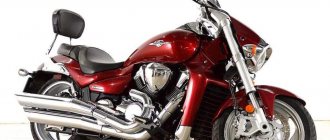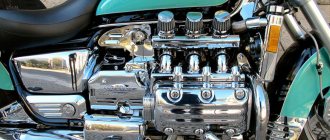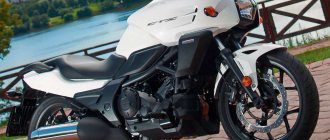| Honda CRF250R (2004-2008) | Honda CRF250R (2009-2012) | Honda CRF250R (2014-2016) |
| Honda CRF250R (2017) | Honda CRF250R (2018-2021) | Honda CRF250R (2022+) |
| Honda CRF250X (2004-2017) | Honda CRF250RX (2018-2021) | Honda CRF250RX (2022+) |
Honda CRF250 Off-Road Motorcycle Series
appeared in September 2003 (2004 model year), introducing two models to the market -
Honda CRF250R
(cross) and
Honda CRF250X
(enduro). These models positioned themselves as a replacement for the obsolete XR line, as well as the 2-stroke motocross model Honda CR250R.
The Honda CRF250R and Honda CRF250X were targeted at the European, North American, Australian and Japanese markets (the CRF250X was available there from late 2010).
The Honda CRF250 series was based on a 1-cylinder, 4-stroke, liquid-cooled engine with a volume of about 250 cm³, with one camshaft and 4 valves. The engine modification for the cross-country version of the Honda CRF250R featured more boost, an exhaust system and constant changes every few years. The engine for the Honda CRF250X has been virtually unchanged from 2004 to 2021.
Both models were equipped with an aluminum frame, adjustable sports suspension (inverted fork with a diameter of 47 mm + swingarm with a progressive Pro-Link system and fully adjustable shock absorber), disc brakes and a 5-speed gearbox.
The Honda CRF250R model underwent the first serious restyling in 2009. The motorcycle received a new version of the engine with an increased compression ratio and an injection power system. The engine has also been strengthened through the use of stiffer valve springs and stronger aluminum piston material. The frame has become thinner and lighter, the wheelbase and swingarm length have been increased, and the diameter of the fork stays has been increased to 48 mm.
In 2010, as mentioned above, the Honda CRF250X model became officially available on the Japanese market. Unlike the cross version, the CRF250X did not undergo major changes and was still equipped with a carburetor power system.
In 2012, a new budget model Honda CRF250L appears, which, although it has a similar name, does not belong to the full CRF line.
By August 2013, Honda introduced an updated version of the cross-country model Honda CRF250R. The motorcycle received a new generation of frame and pendulum. To improve weight distribution, the exhaust has become double. The suspensions remained the same, but changed their characteristics to suit the new frame and pendulum. New generation of engine - increased compression ratio, modified piston and combustion chamber design, new 2-stage fuel injection system 2 PGM-FI.
In 2021, the Honda CRF250R model receives another major update. New engine - increased the compression ratio, received a new cylinder head with two camshafts (DOHC), new titanium valves, a new intake design, an electric starter instead of a kick. New frame. Electronic systems: 3-stage launch control (HRC Launch Control), engine mode selection (Engine Mode Select Button - EMSB). The new front suspension is an inverted fork with a 49 mm diameter of stays.
For 2021, the Honda CRF250R gets a slight makeover with new camshafts and updated styling. By 2021, the Honda CRF250X model changes its name to Honda CRF250RX
, gets a new look, a new engine from the CRF250R, featuring ignition tuning, suspension tuning and increased fuel tank capacity.
In the summer of 2021, Honda introduced the new 2022 CRF250R and CRF250RX. The updated models received a new generation of frame, new engine settings (more torque at mid-range), 9-disc clutch, single exhaust. The RX modification received hand protection as standard.
The main competitors of the Honda CRF250R (cross) in the class:
- Kawasaki KX250F
- Suzuki RM-Z250
- Yamaha YZ250F
The main competitors of the Honda CRF250X (enduro) in the class:
- Yamaha WR250
- Kawasaki KLX250/KX250X
Brief history of the model
- September 2003 (2004 model year) - start of production and sales.
Model
: Honda CRF250R;
Honda CRF250X (Europe, North America, Australia, Japan). Factory designation:
CRF250R4; CRF250X4.
- 2005 - no significant changes.
Model
: Honda CRF250R;
Honda CRF250X (Europe, North America, Australia, Japan). Factory designation:
CRF250R5; CRF250X5.
- 2006 - no significant changes.
Model
: Honda CRF250R;
Honda CRF250X (Europe, North America, Australia, Japan). Factory designation:
CRF250R6; CRF250X6.
- 2007 - no significant changes.
Model
: Honda CRF250R;
Honda CRF250X (Europe, North America, Australia, Japan). Factory designation:
CRF250R7; CRF250X7.
- 2008 - no significant changes.
Model
: Honda CRF250R;
Honda CRF250X (Europe, North America, Australia, Japan). Factory designation:
CRF250R8; CRF250X8.
- 2009 - restyling of the Honda CRF250R model.
Model
: Honda CRF250R;
Honda CRF250X (Europe, North America, Australia, Japan). Factory designation:
CRF250R9; CRF250X9.
- October 2010 - the Honda CRF250X model receives LED optics and begins to be sold in Japan. Since this CRF250X model comes as a 2011 version, this modification was not officially produced in 2010.
Model
: Honda CRF250R (Europe, North America, Australia, Japan).
Factory designation:
CRF250RA.
- 2011 - no significant changes.
Model
: Honda CRF250R;
Honda CRF250X (Europe, North America, Australia, Japan). Factory designation:
CRF250RB; CRF250XB.
- 2012 - no significant changes.
Model
: Honda CRF250R;
Honda CRF250X (Europe, North America, Australia, Japan). Factory designation:
CRF250RC; CRF250XC.
- 2013 - restyling of the Honda CRF250R model.
Model
: Honda CRF250R;
Honda CRF250X (Europe, North America, Australia, Japan). Factory designation:
CRF250RD; CRF250XD.
- 2014 - The CRF250X was not modified this year.
Model
: Honda CRF250R (Europe, North America, Australia, Japan).
Factory designation:
CRF250RE.
- 2015 - no significant changes.
Model
: Honda CRF250R;
Honda CRF250X (Europe, North America, Australia, Japan). Factory designation:
CRF250RF; CRF250XF.
- 2016 - no significant changes.
Model
: Honda CRF250R;
Honda CRF250X (Europe, North America, Australia, Japan). Factory designation:
CRF250RG; CRF250XG.
- 2017 - restyling of the Honda CRF250R model.
Model
: Honda CRF250R;
Honda CRF250X (Europe, North America, Australia, Japan). Factory designation:
CRF250RH; CRF250XH.
- 2018 - Honda CRF250X is no longer produced. Restyling of the Honda CRF250R model.
Model
: Honda CRF250R (Europe, North America, Australia, Japan).
Factory designation:
CRF250RJ.
- 2019 - restyling of the Honda CRF250X, which now has a different name - Honda CRF250RX.
Model
: Honda CRF250R;
Honda CRF250RX (Europe, North America, Australia, Japan). Factory designation:
CRF250RK; CRF250RXK.
- 2020 - no significant changes.
Model
: Honda CRF250R;
Honda CRF250RX (Europe, North America, Australia, Japan). Factory designation:
CRF250RL; CRF250RXL.
- 2021 - no significant changes.
Model
: Honda CRF250R;
Honda CRF250RX (Europe, North America, Australia, Japan). Factory designation:
CRF250RM; CRF250RXM.
- 2022 - restyling of the model. New generation of frame (less weight, better cornering), new engine settings to improve mid-range performance (new camshaft sprocket, new timings for opening/closing valves and ignition), new clutch (9 discs, smoother torque transmission, lighter squeeze), a new exhaust system (two mufflers were replaced by one), a new front fork (travel increased by 5 mm), the RX version received stock hand protection.
Model
: Honda CRF250R;
Honda CRF250RX (Europe, North America, Australia, Japan). Factory designation:
CRF250RN; CRF250RXN.
Video review of Honda CRF 250
The front fork is an inverted type, twin-tube, telescopic, Showa brand with a full range of adjustments. The Honda CRF 250 X has fork legs with a diameter of 49 mm and suspension travel of 310 mm. The Honda CRF 250 R has a 47 mm fork and 315 mm of travel. Steering column with Honda progressive steering damper.
The rear suspension is pendulum, with a progressive Pro-Link Showa monoshock absorber, which has a full range of adjustments. The only difference is the suspension travel: for the CRF 250 X it is 312 mm, and for the CRF 250 R it is 315 mm.
Front wheel with tire size 80/100 R21. The rear ones are different: the CRF 250 X has 100/90 R19, and the CRF 250 R has 100/100 R18. Aluminum rims with wire spokes. The front brake is single disc, with 2-piston caliper. The only differences are in the size of the disc: for the CRF 250 X it has a diameter of 260 mm, for the CRF 250 R it has a diameter of 240 mm. The rear brake is the same: one disc with a diameter of 240 mm and a 1-piston caliper. Both brakes are hydraulic, the brake pads are metallized.
The fuel tank capacity of the CRF 250 X is 6.5 liters, and that of the CRF 250 R is 7.2 liters. There are also slight differences in the curb weight: for the 250 X modification it is 105 kg, for the 250 R it is 115 kg.
Honda CRF 250
Reviews
Reviews about Honda CRF 250:
Expand Collapse
Traditionally for the “red and white”, the CRF250X is equipped with an inverted two-chamber Showa cartridge fork with a 47 mm diameter of stays. I would like to make a reservation right away: if a motorcycle is destined for a sporting destiny, it cannot be done without the intervention of a specialist. The stock suspension is too soft. Of course, its energy intensity is quite enough for amateur country trips, but on a serious track the Showa starts to get tired quite quickly. But the potential of the braking mechanisms is enough, as they say, with a reserve.
The motorcycle has excellent weight distribution, with 46.8% of its total weight falling on the front axle. That's why the CRF250X has very light and sharp handling. Despite the loose and soft suspension settings, the motorcycle handles almost at the same level as its sportier cross-country cousin.
But when purchasing a CRF250X, you need to clearly understand that in order to participate in serious competitions, this “semi-finished product” will have to be seriously modified. First of all, you need to seriously invigorate the engine. Work some magic with the carburetor and modify the airbox of the motorcycle, as well as replace the stock parts with the appropriate tuning ones. The crankshaft, piston, cylinder, ignition unit, camshafts and exhaust system all need to be replaced. All this wealth, of course, will need to be properly tuned on the dyno. In order to match the increased power and torque, you will definitely have to do suspension tuning. You will have to change the springs in the fork and shock absorber. And properly reconfigure the hydraulic suspension system.
Honda CRF250X. The aesthetics of this motorcycle are distinguished by its dual exhaust system. It is created, like Kawasaki, on the basis of motocross models adapted to the enduro class.
The single-shaft timing engine (Unicam system) is very compact, but lacks an electric starter. Quite playful, it demonstrates an impeccable increase in power, both on the artificial track and on the mountain, thanks to the absence of surges at high revs, which guarantees good traction on any surface. This, to some extent, is also its drawback, since on the one hand, the increase in torque is very effective, but on the other hand, it is not very exciting. Like all Hondas, off-road and beyond, it boasts a “natural” front end that allows you to be bold on a man-made track, and on a mountain road to enjoy the ride without worrying too much about the behavior of the front wheel. Its drawback is the reaction of the fork to a series of obstacles: here it responds rather dryly, transmitting shocks to the steering wheel. This is due to the settings, which, although quite smooth, are a little harsh at the first stage, and therefore cannot absorb all irregularities with sufficient accuracy.
Braking is good, but the saddle position could be better, as the handlebars are a little low for standing riding and the footpegs are a bit high. In terms of its performance, Honda is literally ahead of the Husky by a hair.
Technical description
Both modifications 250 X and 250 R are equipped with the same 1-cylinder 249 cc water-cooled engines. Start - electric starter. They differ in compression ratio, power, ignition and power systems.
The Honda CRF 250 X motorcycle has a combustion chamber with a compression ratio of 13.5. Develops a maximum power of 43.7 hp. With. at 11 thousand rpm. The highest torque of 25 Nm is achieved at 8 thousand rpm. The injection system is injection, with control electronics. Ignition is transistorized.
The Honda CRF250R has a lower compression ratio of 12.9 and a correspondingly lower power output of 30 hp. With. at 9 thousand rpm. The fuel delivery system uses a Keihin carburetor with throttle position sensor and 37mm jets. Electronically controlled ignition CDi.
Gearboxes are only mechanical, with 5 steps. Torque is transmitted to the rear wheel by a chain. Aluminum frame, extruded (injection molding technology).
2022 Honda CRF250R Suspensions
The suspension components on the Honda CRF250R are still from Showa, but with some differences. So, the 49th spring fork became 5mm longer, the spring stiffness remained the same, but the smoothing valves were updated. The shock absorber also received new valves, a new ultra-light steel spring of 50 Nm, and in addition, it is installed in a lever system with a new gear ratio.
The pendants are very good even in factory condition. The balance between comfort and support is almost perfect, and even several attempts to change and improve something essentially led to nothing: you drive a couple of laps, twist the fork and rear shock absorber adjusters, and something becomes better, and something worse. The changes are always noticeable, but in the end it turns out that for a middle-weight rider the suspensions are set optimally from the factory, except that the spring is a little soft. But it’s the rear shock absorber spring that a serious rider will select for himself, so this is not even a complaint.
Modifications (CRF250L, CRF250M, CRF250L Rally)
In addition to those described on the Internet, there are references to three more modifications.
- Honda CRF250L - an enduro motorcycle that has common features with the development of the plant CBR250. Deformed engine, complete absence of any settings for the suspension, at least some innovations, steel frame.
It’s better not to go into such jungle on a lightweight version, and Honda itself classifies the L-ku as a dual-purpose bike, and not as an uncompromising “dirt mixer”.
- Honda CRF250M assembled on the basis of the previous one, full compliance with technical characteristics, road tires and wheels of the same diameter classify it as a motard.
Already from its appearance it is noticeable that the M is more oriented towards road use.
- Honda CRF250L Rally is the next stage of development of the L model. Increased height, ground clearance, larger brake discs and stock ABS for European markets.
Apart from the same engine capacity - 248 cm3, there are no other common parts. The first two models were presented by the concern for budget users in 2012.
If we compare in numbers, budget models initially lag behind the R and X versions, which the developers position as the flagships of the line.
Users note that these budget versions have one big advantage - an almost ideal weight distribution of 46/54% , which makes riding such a bike no more difficult than a bicycle ride.
Flaws
- Difficult to maintain.
- It's not easy to catch neutral.
- You need to get used to the sensitive reaction to the movement of the gas/brake handles.
Advantages
- Dynamism and traction.
- Checkpoint.
- Maneuverability.
- Lightweight and manageable.
Motorcycle performance ratings
Both models, according to owners' reviews, provide good technical characteristics in comparison with competitors, have high off-road qualities and are comfortable enough for long driving.
Honda engines are famous for their high power density, low noise (89.9 dB - high for motocross bikes), reliability and durability. Starting the engine using an electric starter is very convenient.
There are also disadvantages. Despite the fact that the electronic injection engine accelerates excellently on short stretches, it behaves mediocrely on long stretches. The power is excellent at medium speeds, not bad at low speeds, but at the top the engine smokes and roars more. The problem is that the standard muffler suffocates the engine too much. The use of a tuning exhaust improves power at the top, but there is no trace of low noise.
Carburetor versions suffer from failures when opening the gas, which does not provide the necessary pickup when exiting turns and landing after jumps. But with a highly skilled approach with the right needle and set of jets, it is still possible to achieve a clear response to the gas.
Thanks to the use of electronic injection on the CRF 250 X, the ignition circuits can be changed simply by reprogramming the control module. This is a modern analogy to replacing jets in carburetors.
The frames have also proven to be highly wear-resistant and sufficiently rigid. The use of aluminum alloy in their design made it possible to reduce the overall weight of the motorcycle. Due to the use of a front fork with insufficient lean angle, the motorcycle suffers from oversteer when entering corners. This manifests itself in the fact that the steering wheel tends to escape from your hands when entering a turn, and on straight sections there is a need to constantly adjust the trajectory. The deficiency is cured by installing a rear pendulum of an extended design.
For all heavier riders (over 75kg), it is recommended to change the fork springs to stiffer ones to prevent the front wheel from diving under braking.
Honda CRF 250
Post Views: 22,481
Chassis and handling Honda CRF250R
The main news is regarding the chassis. The sixth generation CRF250R has received exactly the same improvements as the flagship CRF450R a year ago, and apart from the engine, its mounts and exhaust, everything else is absolutely identical and interchangeable.
The chassis has become lighter, more compact and more stable. The wheelbase is 10mm shorter, the ground clearance is 3mm higher, and the seat height remains the same. The frame, swingarm and subframe are completely new. Even the traverse design has been updated - new stiffening ribs provide greater flexibility, improving handling and feedback.
The entire design has become more thoughtful and convenient in all respects. For example, the airflow of radiators has been improved for more efficient cooling. Even the base of the saddle is new, with a different locking mechanism, eliminating the possibility of it unfastening while moving. The seating position remains comfortable, Honda style, but the silhouette of the motorcycle with its tail up has changed. Surprisingly, despite the increased stability of the new chassis, it is extremely responsive to the rider's movements and handles well.
Honda CRF250R 2022










